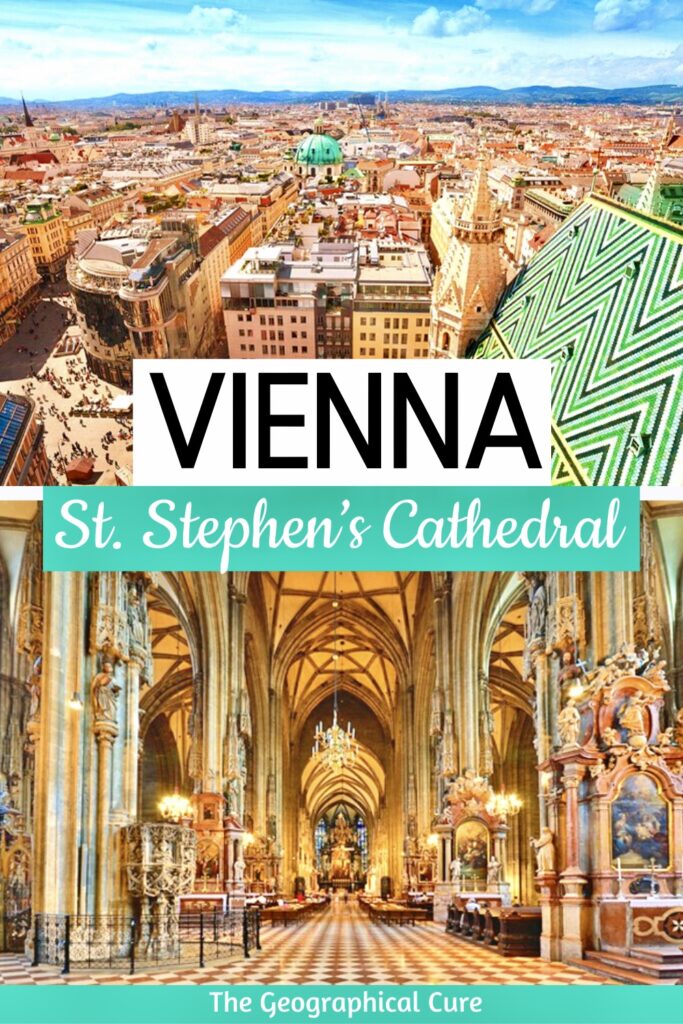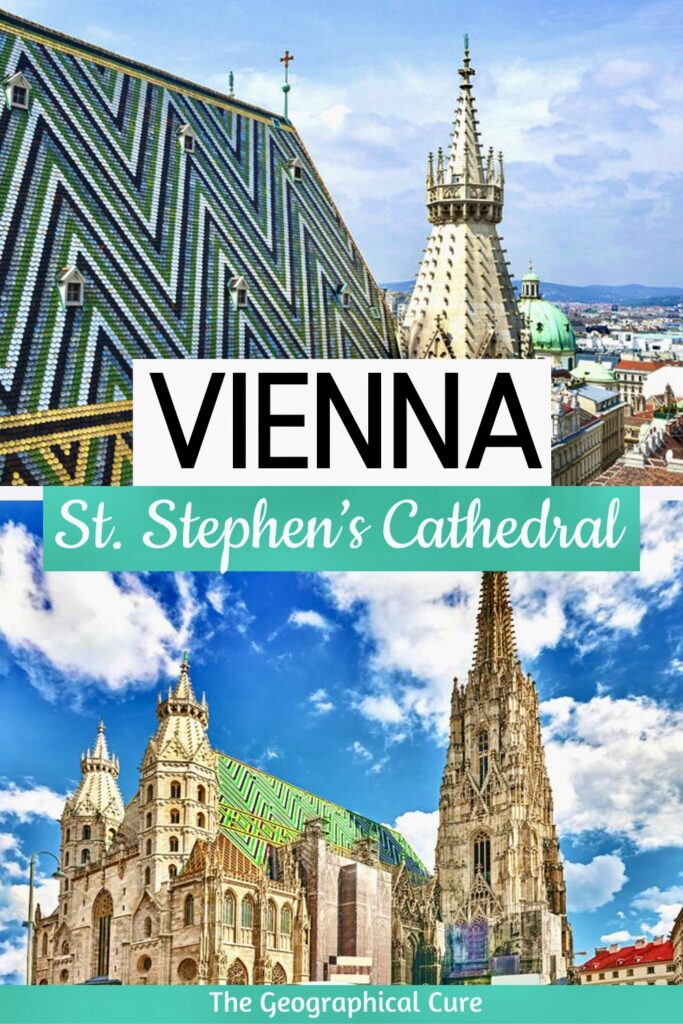In the heart of Vienna, you’ll find St. Stephen’s Cathedral, a remarkable Gothic masterpiece.
It’s the very symbol of Vienna, and the city’s top attraction. Indeed, it’s one of the tallest religious structures in the world. And the panoramic views from its towers are fantastic.
I’ve visited St. Stephen’s several times in my travels in Austria. In this guide, I’ll tell you everything to see inside and give you must know tips for visiting.
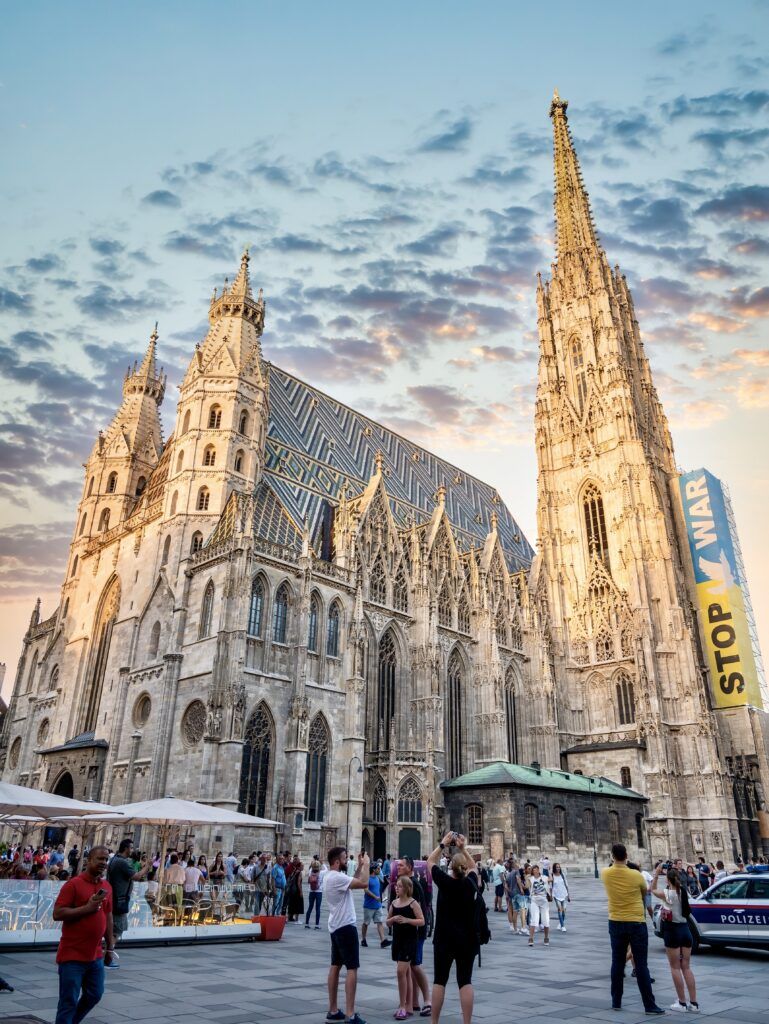
St. Stephen’s Cathedral At A Glance
Here’s a snapshot glance at what you can see at St. Stephen’s Cathedral:
- exterior facade
- tiled roof
- interior
- Kaiser Oratory
- high altar
- Wiener Neustadter Altar
- tomb of Frederick III
- pulpit
- north tower
- south tower
- catacombs
- treasury
- Dom Museum
In high season, you will want to pre-book an all inclusive ticket to avoid long queues. You can also book a combined ticket to the cathedral and the Dom Museum. That museum houses religious artifacts belonging to the Vienna Archdiocese and contemporary art.
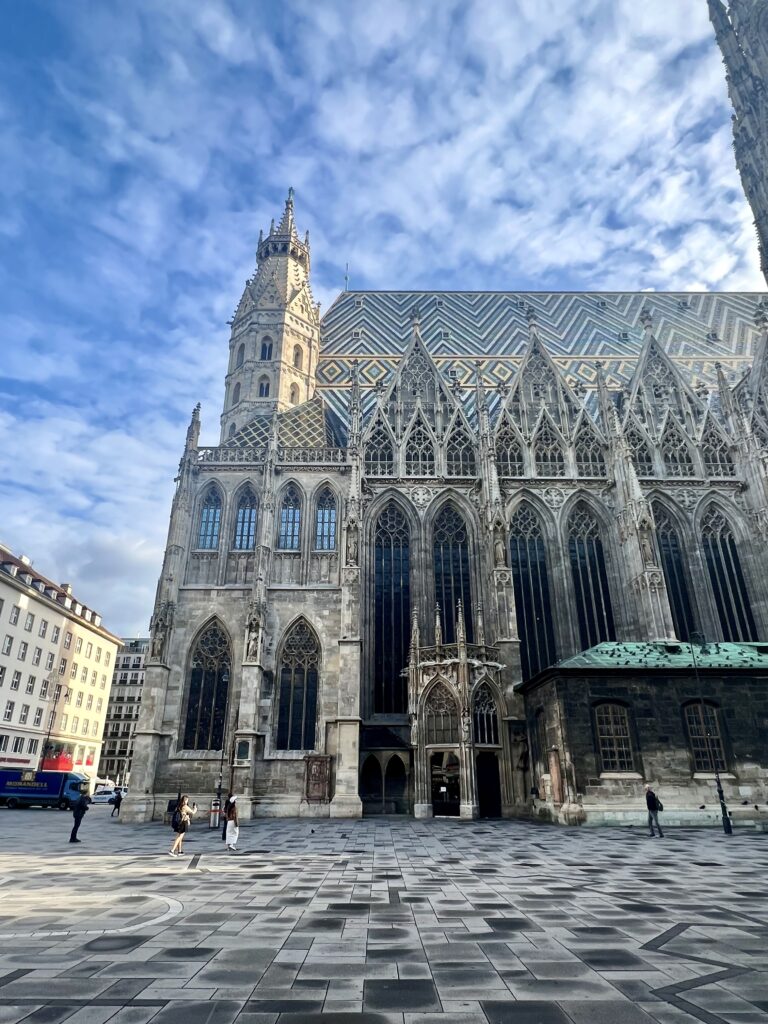
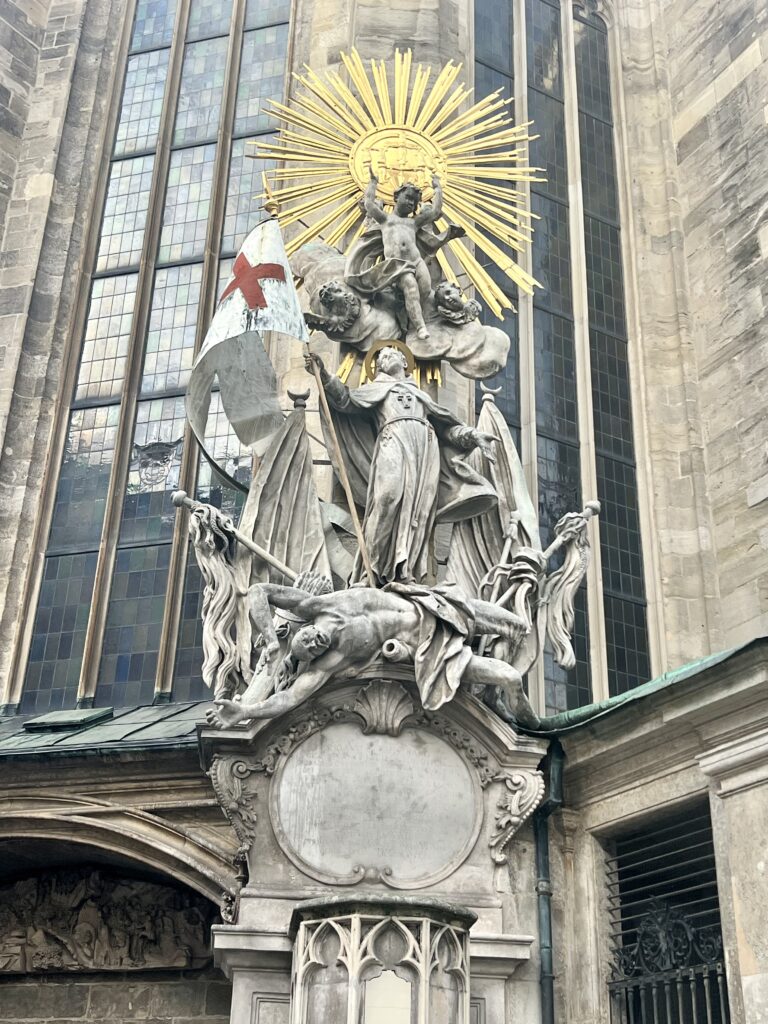
Guide To St. Stephen’s Cathedral: What To See
Here are the highlights and things you can’t miss on a visit to St. Stephen’s Cathedral:
1. Exterior
St. Stephen’s Cathedral was initially built in 1160. But a devastating fire in 1258 left little more than its stone foundations intact.
Consequently, the structure you see today dates back to the 14th century, with construction halting in the early 16th century.
Remarkably, one element that survived the centuries is the main entrance, known as the “Giant’s Gate.” It’s a Romanesque gate, dating from the early 13th century.
At the top, you’ll find a depiction of Christ Pantocrator seated in glory, accompanied by his apostles. His hand is raised in a gesture of blessing, a symbol of faith and reverence that welcomes you to the church.
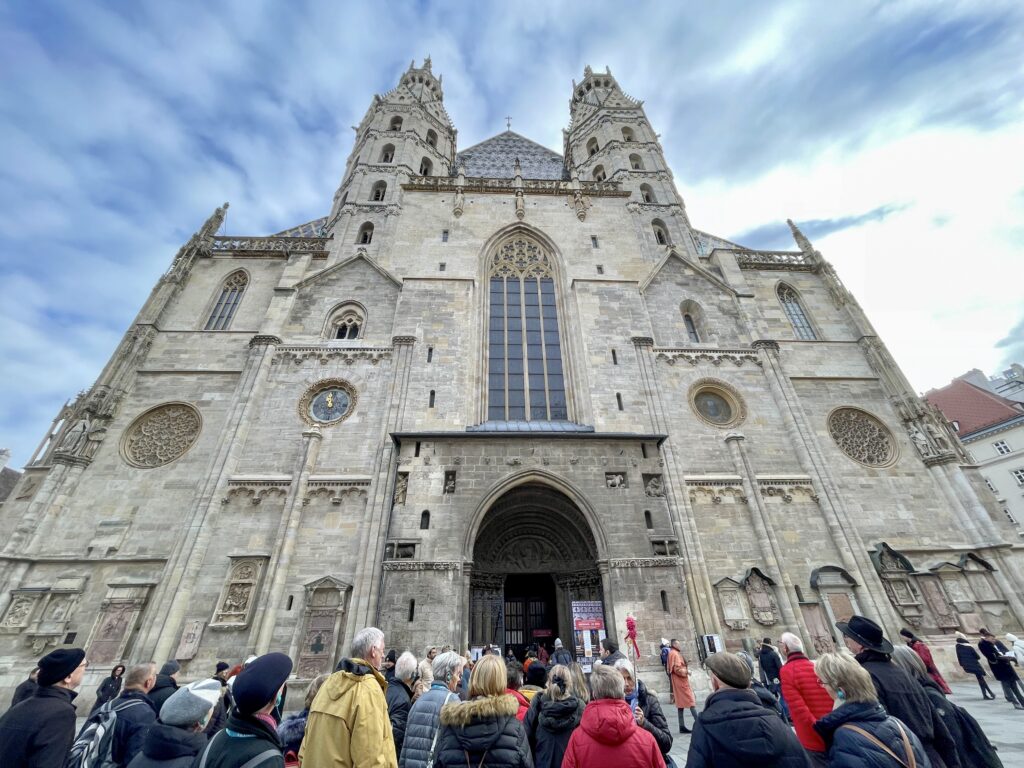
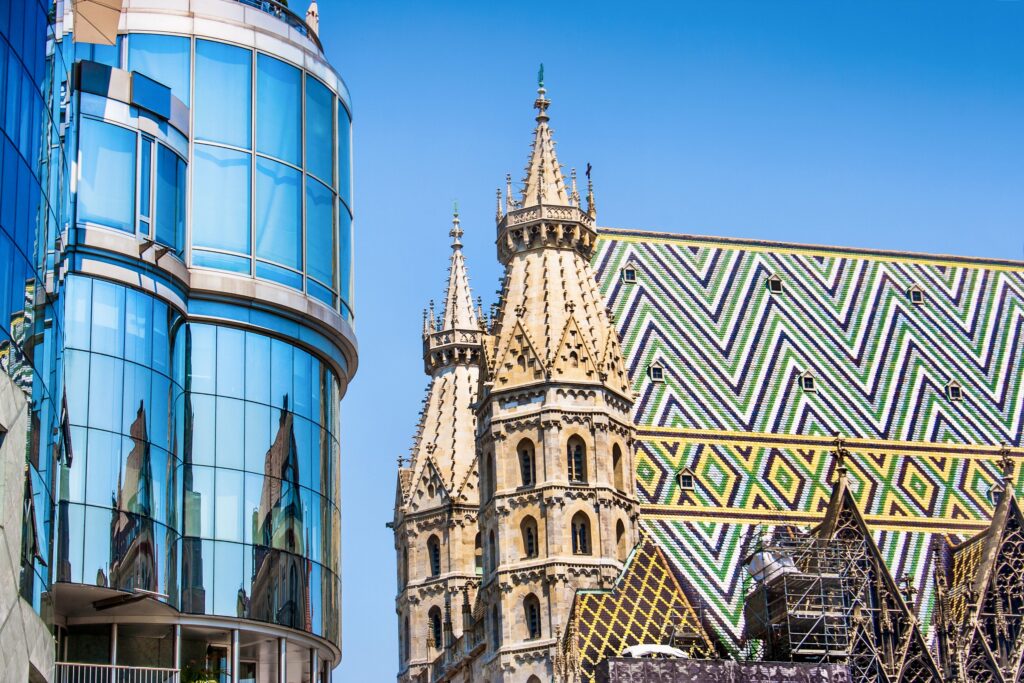
The North Tower was left incomplete, likely due to financial and political challenges. It’s shrouded in local lore, with some claiming it was the “work of the devil.”
The facade boasts intricate carvings, sculptures, and statues, each depicting religious scenes and figures. Parts of the facade are under scaffolding. Others appear to need a serious power washing.
The entire western side of Stephenplatz was destroyed during bombing raids in 1845. Consequently, the neighboring buildings are relatively newer and contrast starkly with the cathedral’s traditional aesthetic.
One example is the Haas House, completed in 1990. It has an ultra modern curved glass design. Yet, its mirrored surface reflects the cathedral, a nice touch.
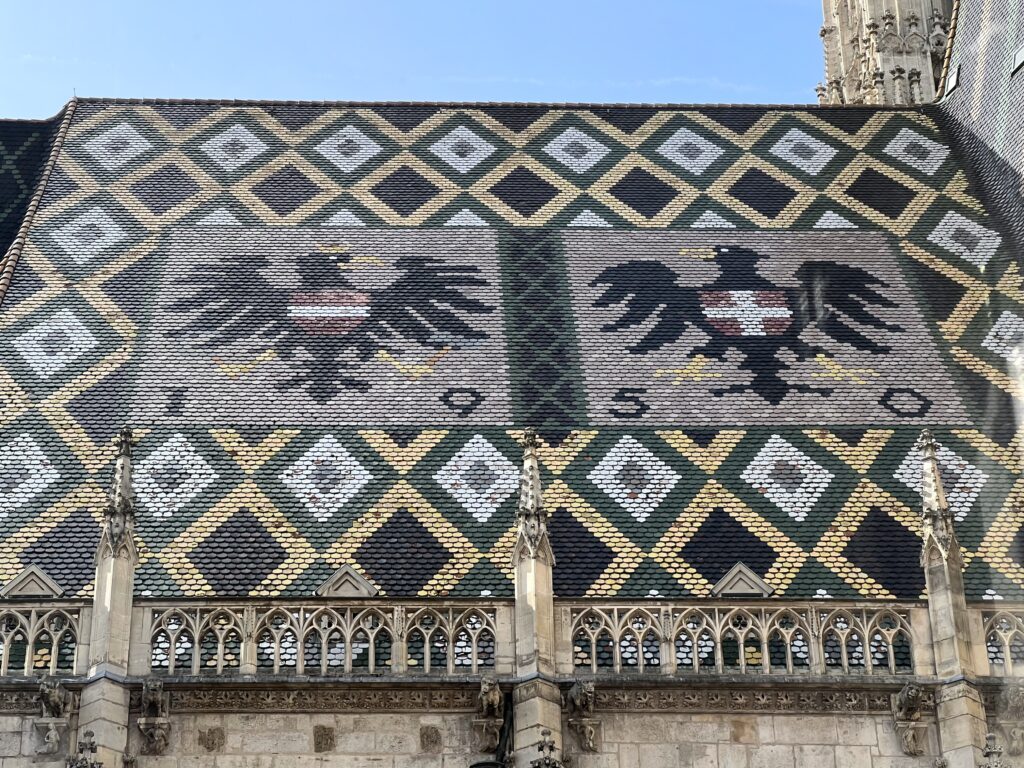
2. Tiled Roof
The roof is a standout feature with colorful glazed tiles. Around 230,000 tiles form a striking diamond pattern in white, yellow, green, and brown colors.
On the north side, you’ll spot the coats of arms of Vienna and Austria.
Interestingly, a tour guide told me that the roof’s pattern matches the textile that was wrapped around the founder, Rudolph IV, upon his death.
During WWII, the roof was destroyed by fire. But it was reconstructed exactly as it appeared before, reopening in full glory in 1952.
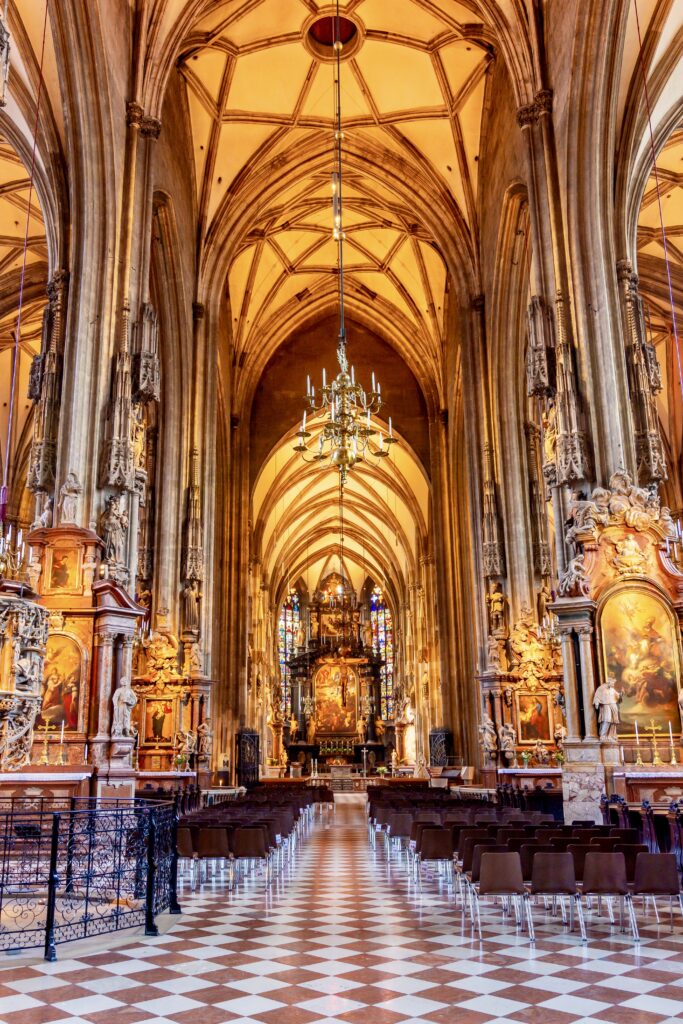
3. Interior
Happily, unlike other European cathedrals, St. Stephen’s was never scrubbed bare by Protestant reformers. It’s simply lovely, giving off medieval vibes. The sheer scale of the interior is breathtaking.
Every one of the columns is decorated with life size statues of biblical figure and saints. Some are carved from colorful and exotic stone.
4. Kaiser Oratory
The Kaiseroratorium, or Kaiser’s Oratory, is located in the cathedral’s southern apse. It was essentially the emperor’s private prayer room. The oratory features a richly decorated altar and a beautiful canopy.
The emperor used the space when he attended important religious ceremonies. It’s a symbol of the close relationship between the Habsburg monarchy and the Catholic Church, emphasizing the emperor’s divine right to rule.
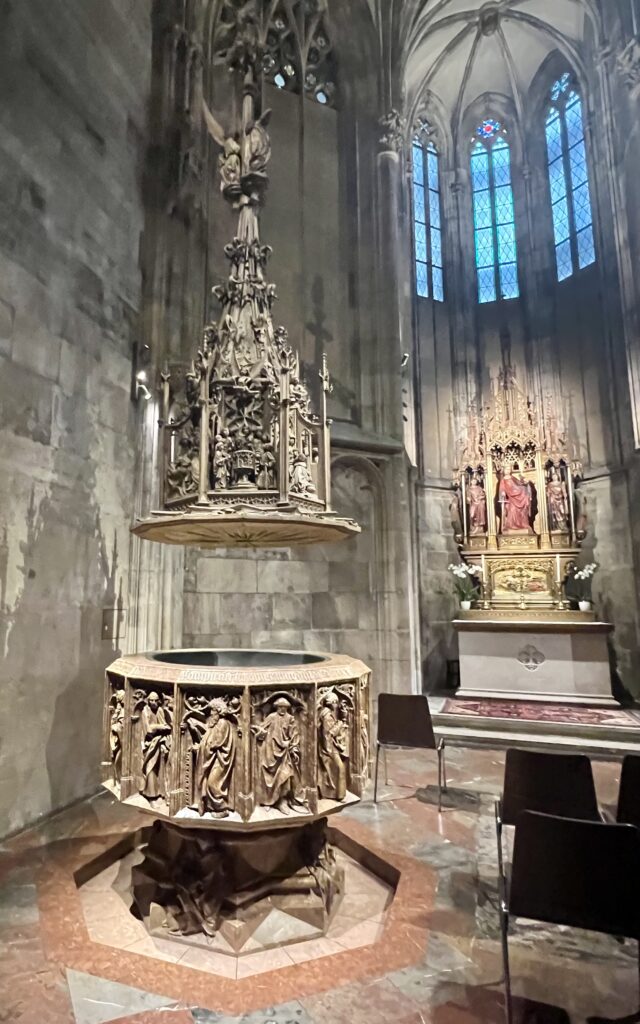
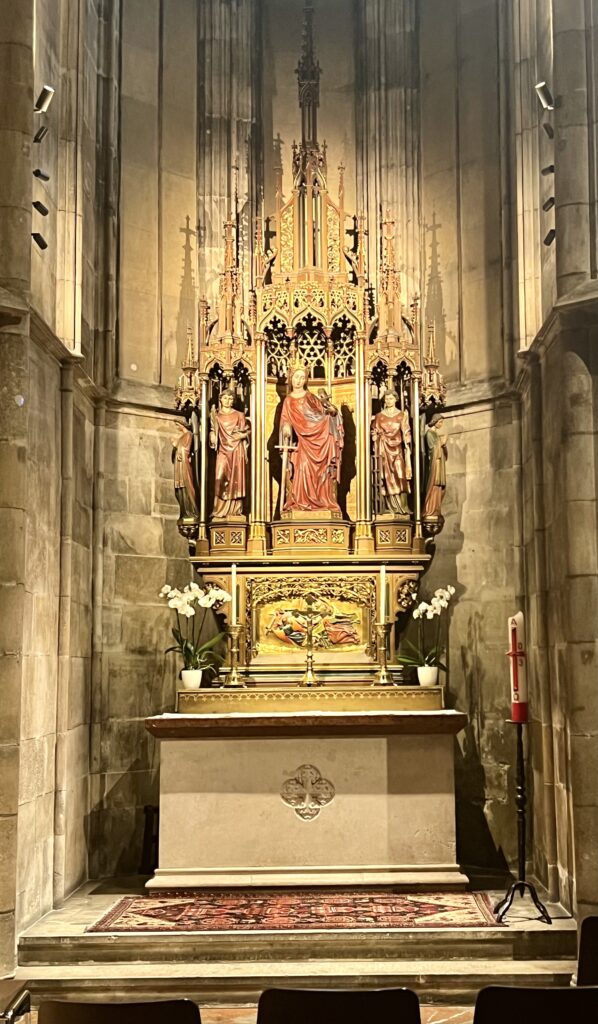
5. St. Catherine’s Chapel & Baptistery
St. Catherine’s Chapel is situated within the southern side of the cathedral. It’s dedicated to St. Catherine of Alexandria, a Christian martyr who lived in the early 4th century and was tortured with a wheel.
There’s a gilded Neo-Gothic altar with the saint in the middle, made in 1825. She’s holding the instruments of her martyrdom, a sword and wheel.
The chapel is now used as a baptistery. The intricately craved baptismal font is made of Salzburg marble.
6. High Altar
The high altar is a spectacular affair, a Baroque masterpiece created by the renowned artist Tobias Pock. It’s meant to look like the portal of a door.
It shows the stoning of St. Stephen. There are elaborate Gothic stained glass windows. At the top is sculpture of the immaculate conception.
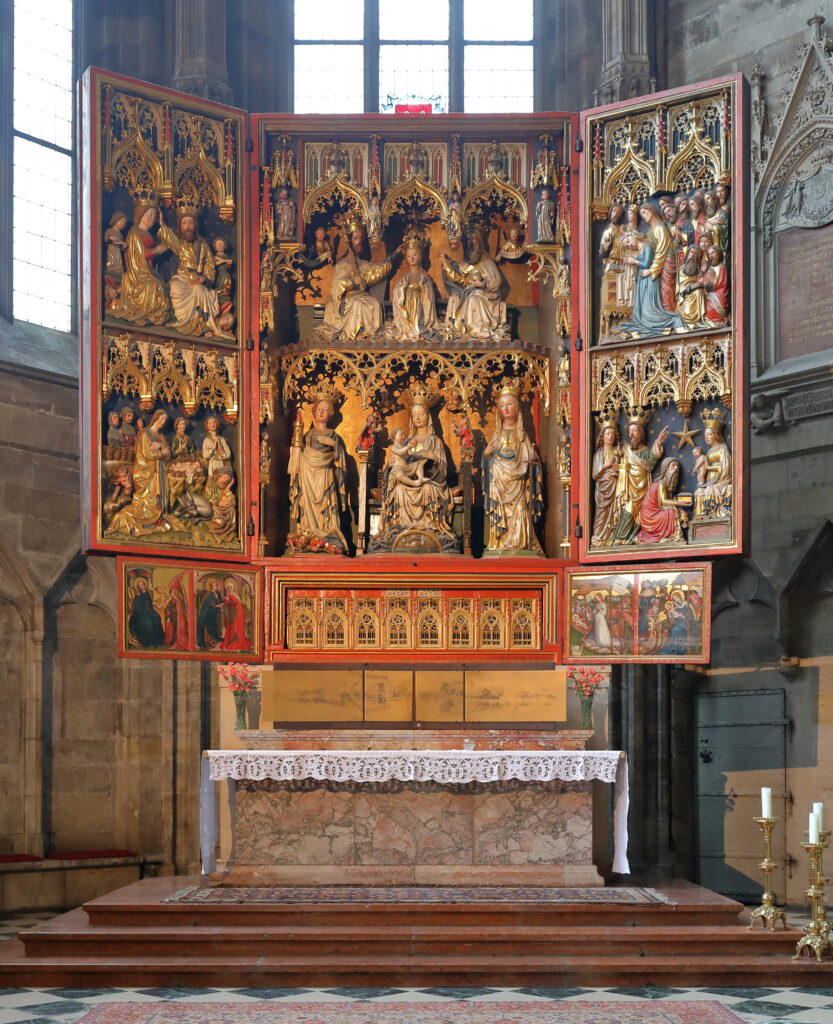
7. Wiener Neustadter Altar
The Wiener Neustadter Altar is one of the cathedral’s treasures, a gift from Frederick IV (later Holy Roman Emperor Frederick III). It’s a richly painted and gilded polyptych in the left chapel of the choir.
It’s a “winged altar “with a main shrine and four moveable parts on the sides that can be closed. The altar has decorative screens with carved figures that were mounted directly on the altarpiece.
It illustrates scenes from the Virgin’s life, from the birth of Christ to her coronation in heaven. For a time, this altar served as the cathedral’s high altar.
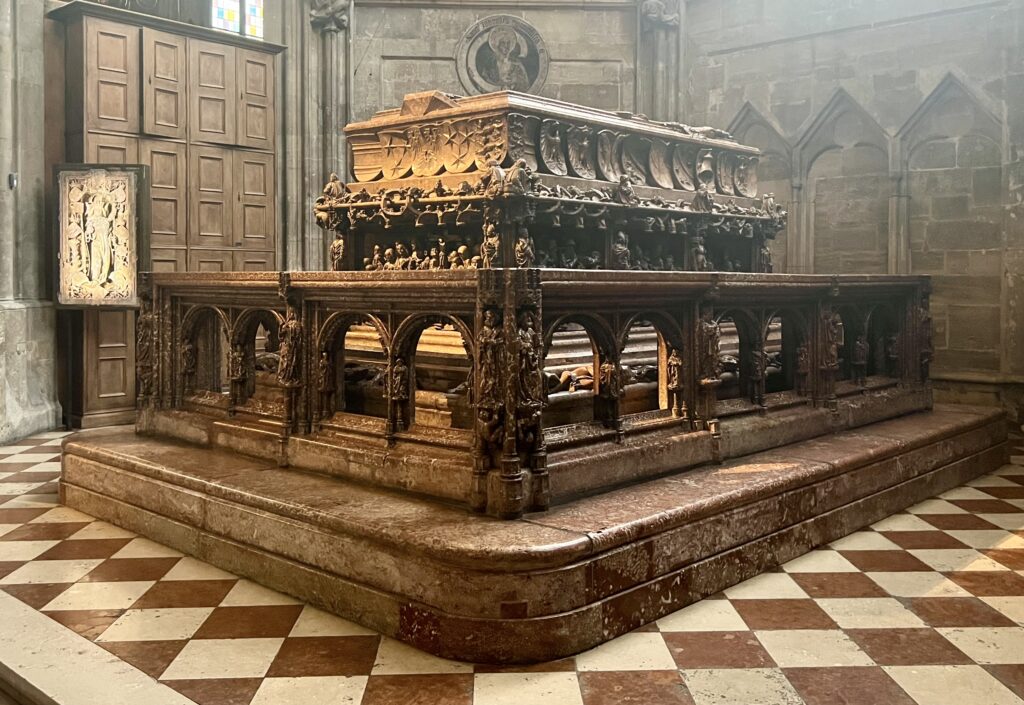
8. Tomb of Emperor Frederick III
The funerary tomb of Emperor Frederick III is in the Choir of the Apostles on the south side of the high altar. It’s one of the most important works of late Gothic sculpture.
The tomb is a dark red Renaissance piece carved by Dutch sculptor Nikolaus Gerhaert van Leyden , a leading artist in the 15th century.
On the lid, you’ll see the recumbent figure of Frederick in his coronation finery holding his crown, scepter, and orb.
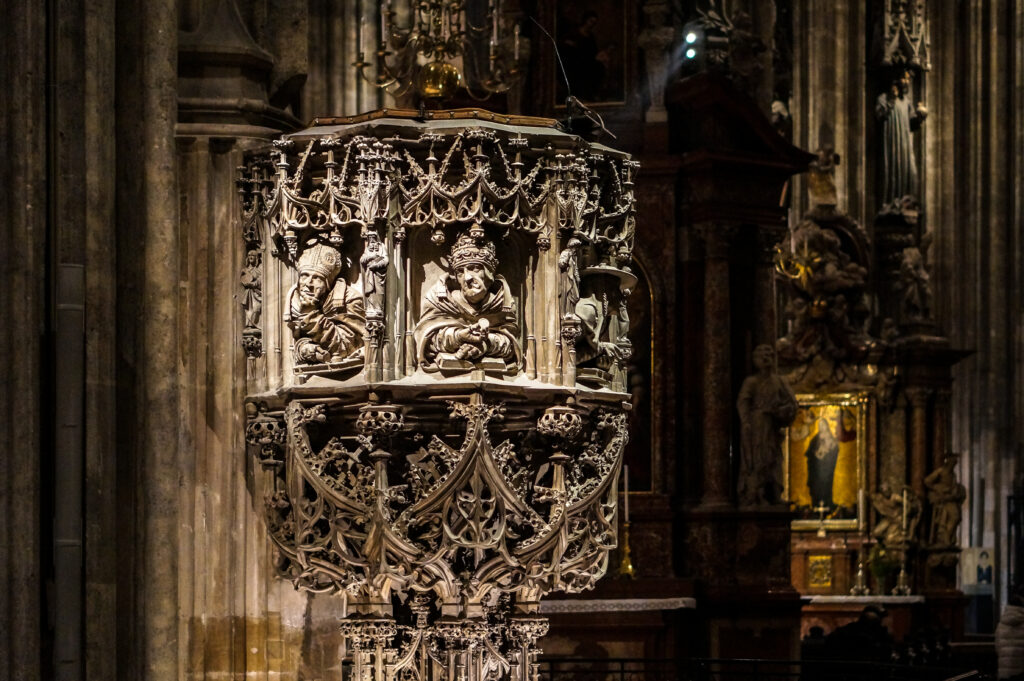
9. Pulpit
The 15th century pulpit is the undisputed highlight of the cathedral interior. It stands against a pillar in the center of the nave.
It’s renowned for the astonishing intricacy and delicacy of its stonework. The pulpit is thought to be the work of either Van Leyden or of Anton Pilgram.
The lower part of the pulpit is a tree-like piece of Gothic tracery. The upper part holds busts depicting the four Doctor of the Church.
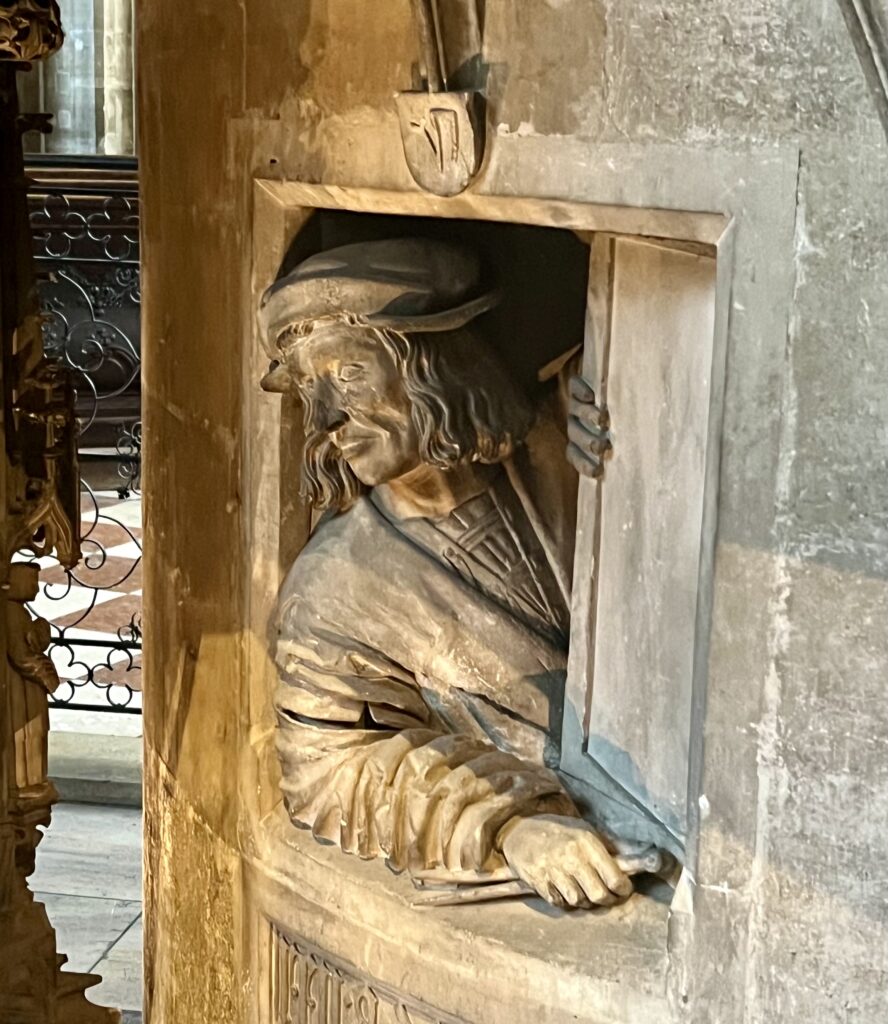
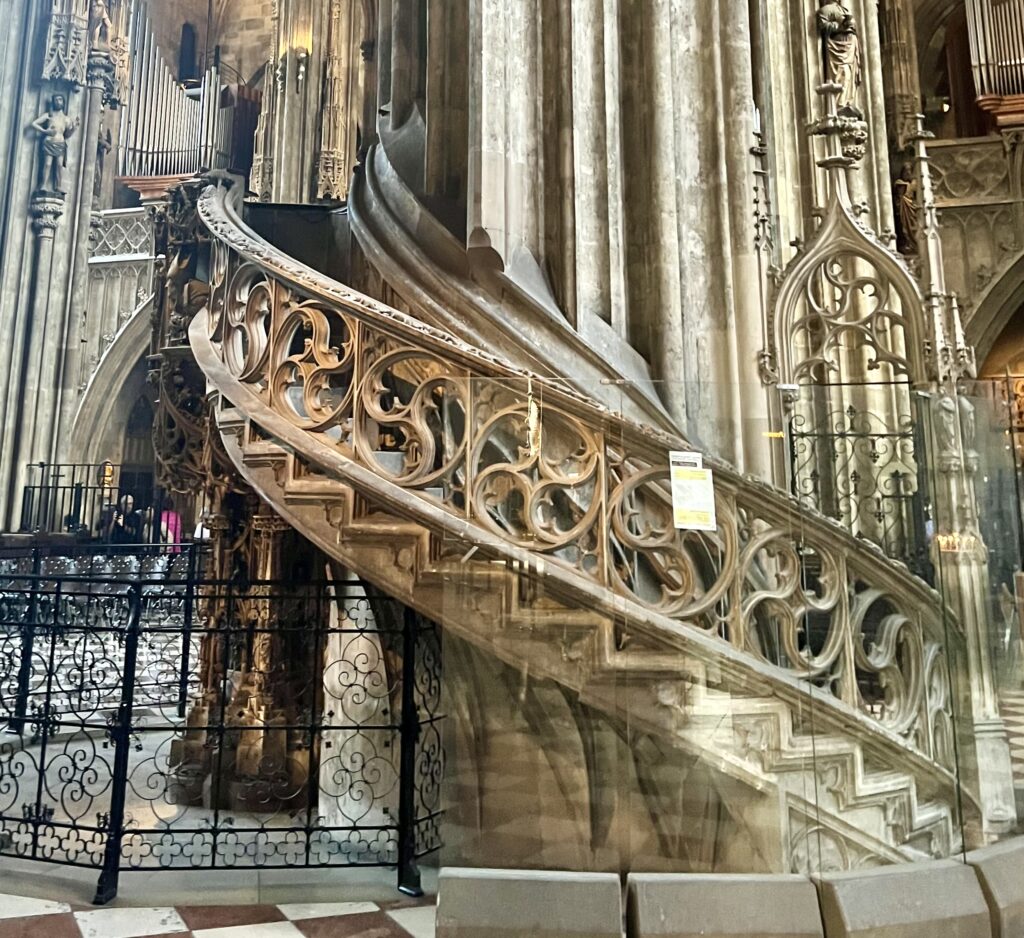
The most distinctive feature is hidden under the stairs — a carving of a man leaning out of window with a chisel in hand. It’s dubbed the “window gawker.”
The carving is thought to be a self-portrait of the mason, whomever he was.
The pulpit’s handrail also has toads and lizards, symbols of evil. They are warded off by a dog, a symbol of good, nicknamed the “fearless doggy.”
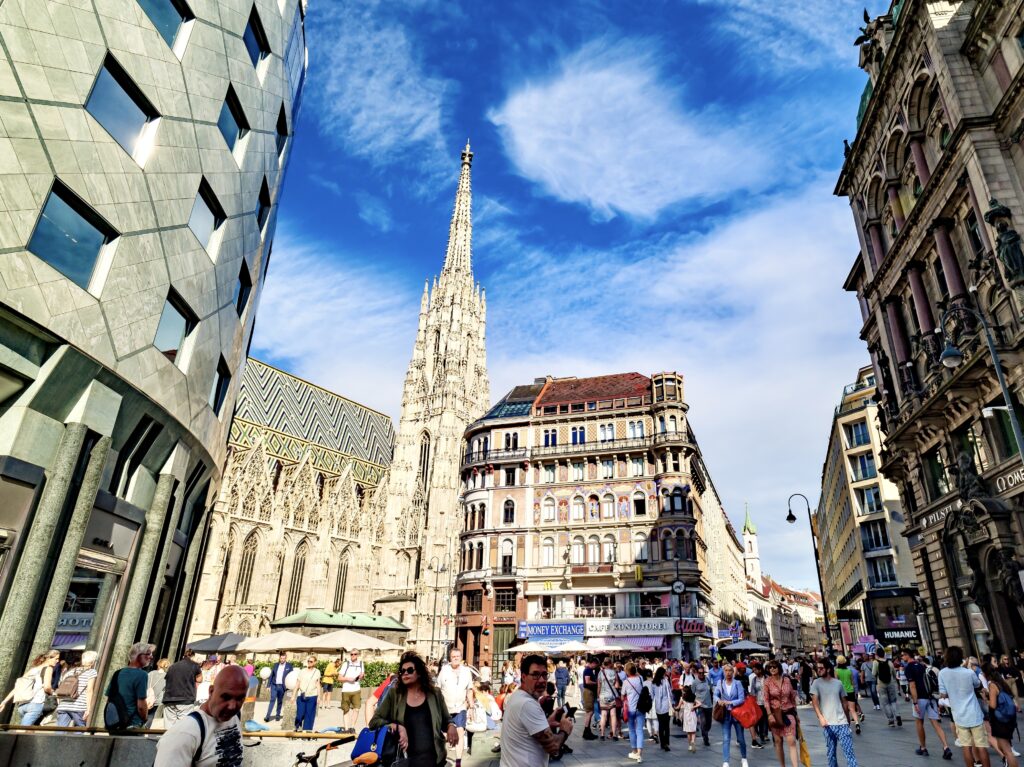
10. South and North Towers
There are two towers at the cathedral, the North Tower and the South Tower. The South Tower is higher at almost 450 feet. The North Tower is about 225 feet.
The towers are home to a collection of 23 bells, many of which are celebrated as some of the most beautiful and elaborate in all of Europe. Among these, the crowning jewel was once the Pummerin bell in the North Tower.
Weighing in at just over 222 tons, it was the second-largest chimed church bell across the entire continent of Europe. When it was first raised, it took a team of 16 men to install it.
In WWII, however, a fire caused it to crash and shatter on the ground below. In 1951, a new bell was made and officially called St. Mary. Because it’s massive and makes the building vibrate. So, it’s only rung several times a year.
The main difference between the two towers is access. You can only reach the summit of the South Tower via 343 steps on a narrow, spiraling stone staircase.
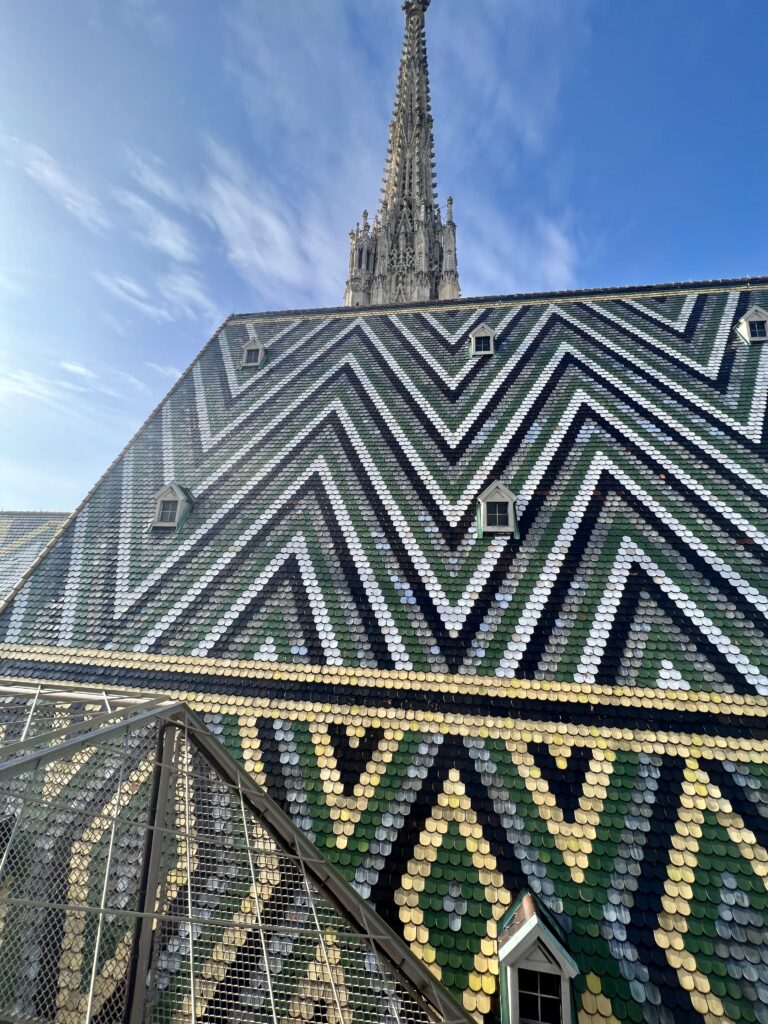
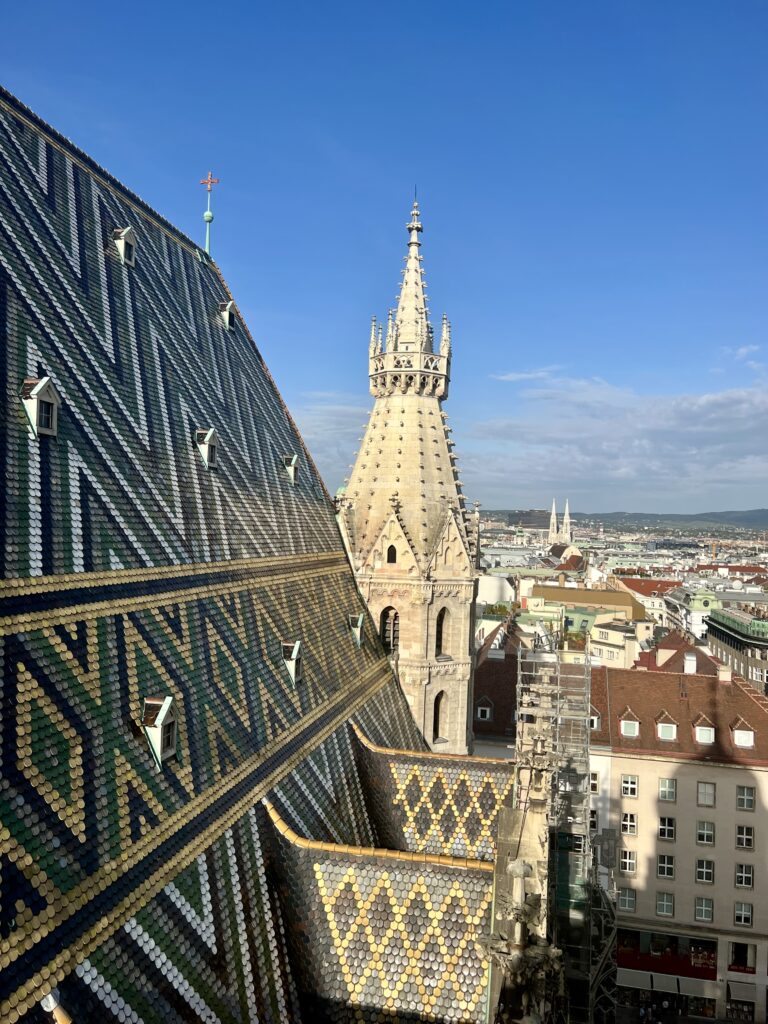
There is no handrail and it is a two way route. So, as you are ascending or descending you will encounter other people and it’s hard to pass.
The South Tower has a separate entrance at Stephenplatz 1. You don’t go in the main door of the cathedral. The entrance is on the left side as you are facing the front of the cathedral.
A ticket for just the South Tower costs 6 euros. As with most churches in Vienna, you can only pay in cash. The South Tower is also included in the all-inclusive ticket. From it, you’ll have panoramic city views in all directions.
In contrast, the North Tower has an elevator. So it’s much easier to get to the top. Access is from inside the cathedral and you can pay 6 euros to get a ticket before you ascend.
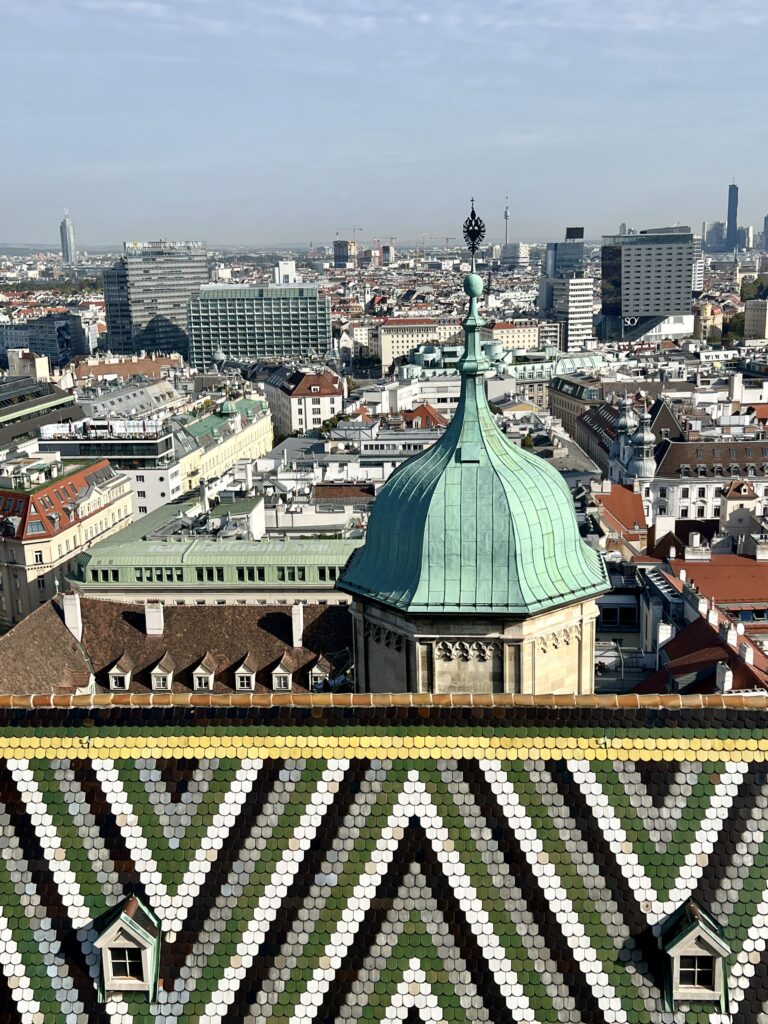
Both towers have great views, even though most people opt for the South Tower. But if you don’t care for the rather uncomfortable hike, the North Tower is a great option.
From it, an open air platform gives you views in many directions and you can still see the tiled roof. Be sure to go up the flight of stairs, which is hidden away in a corner of the platform. I almost missed them.
In sum, choose the South Tower if you don’t mind a hike and want spectacular city views. If you prefer convenience, choose the North Tower.
Both are included in the full ticket. I’ve visited several times now and climbed both towers. While the South Tower gives you better views, I enjoyed the North Tower perfectly well.
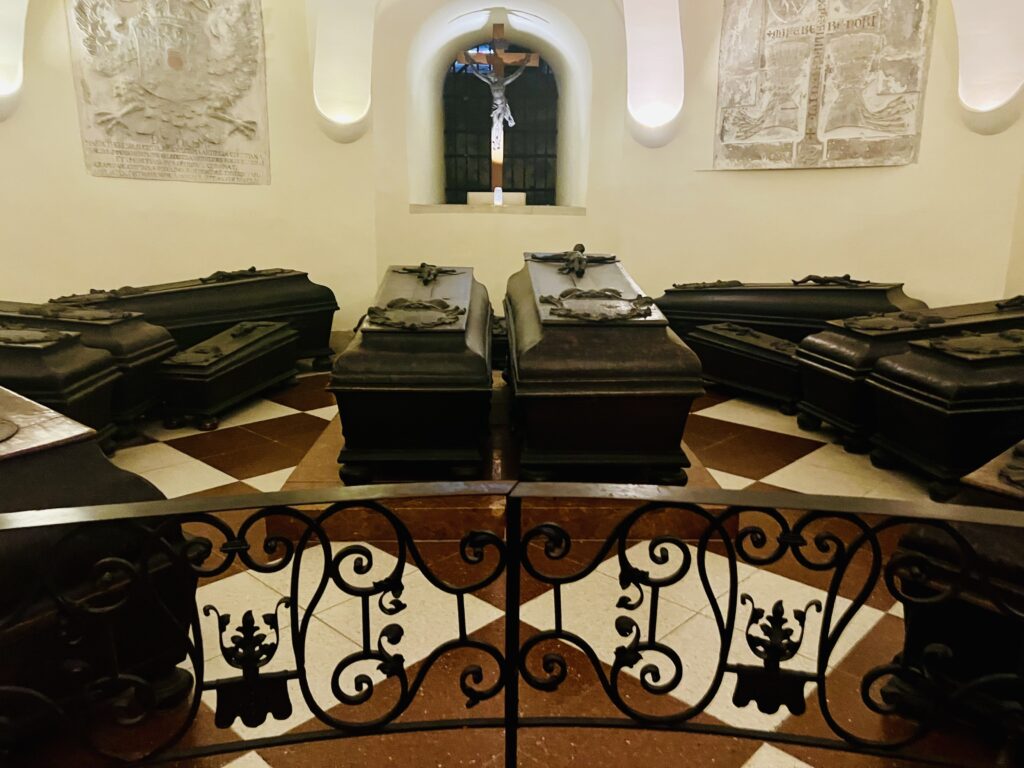
11. Catacombs
The catacombs are the cathedral’s graveyard. it contains the sarcophagi of kings, kings, dukes, archbishops, and other notable figures.
The church was built atop Roman and early medieval cemeteries and itself has served as a crypt for numerous centuries. Visiting this subterranean area is a way to step back in time.
You start in the old catacombs, which date from the 14th century. The first room is the Bishop’s Crypt, then next is the Duke’s Crypt beneath the high altar.
In one chamber, there are 15 copper coffins. The most important contains the remains of the founder of the University of Vienna.
One each side of the hallway leading to the coffins, are stacks of urns behind a barrier. They contain the inner organs of the Hapsburgs. Royalty was always buried in parts. So, their liver and kidneys are at St. Stephen’s and their hears are buried separately in the Augustine Church.
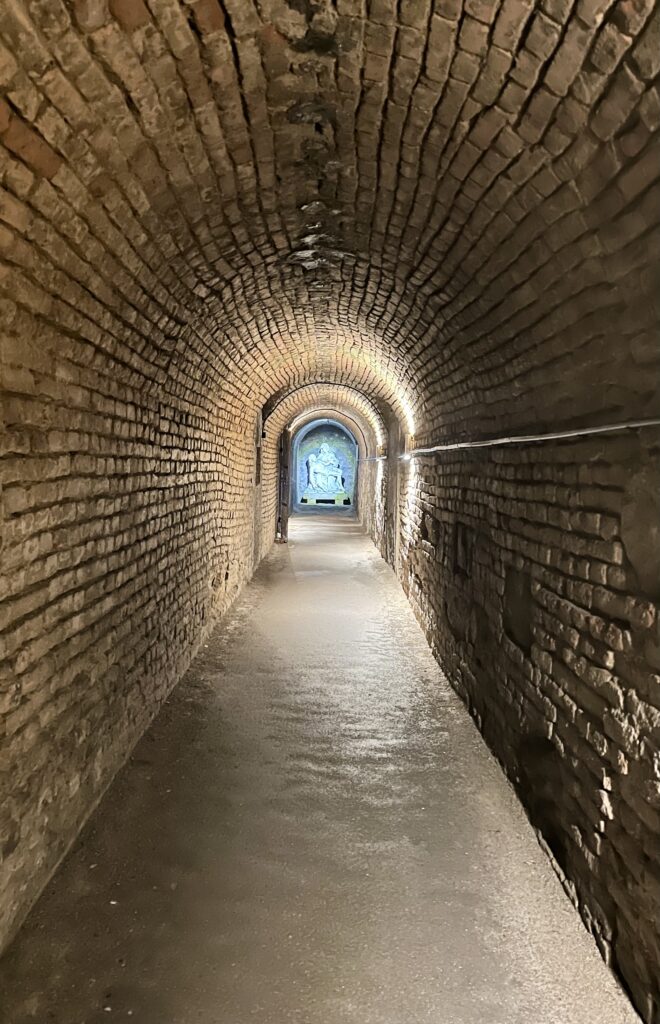
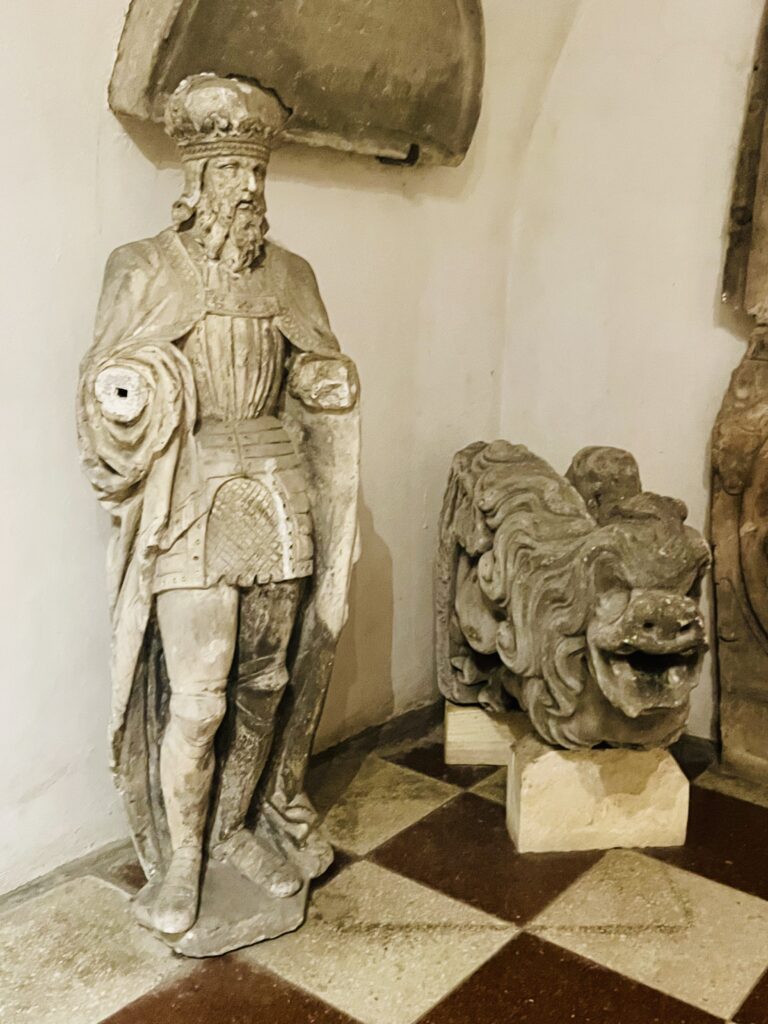
The new catacombs were once a private graveyard from 1745-85 until they ran out of space. You’ll see stony corridors and rooms stacked with bones. Prisoners were the ones forced to clean and stack the bones to prepare them for the catacombs.
The catacombs rooms are thematic and sorted by bone type. Like the royals, even the common folks were buried in parts. One room houses an ancient stone coffin. It’s said to be the oldest guy from Roman times.
To find the catacombs, head down the left aisle in the free zone. The entrance to the catacombs is just past the entrance to the North Tower. You will head down a flight of stairs.
The tour lasts about 25-30 minutes and is in both German and English. Your tour guide will collect tickets or inspect your all-inclusive pass at the end of the tour. So don’t venture down there without a ticket or cash to pay for a ticket.
It’s dark down there, so be sure to watch your step (and your head at times!).
>>> Click here to book a 2.5 hour guided tour of the catacombs
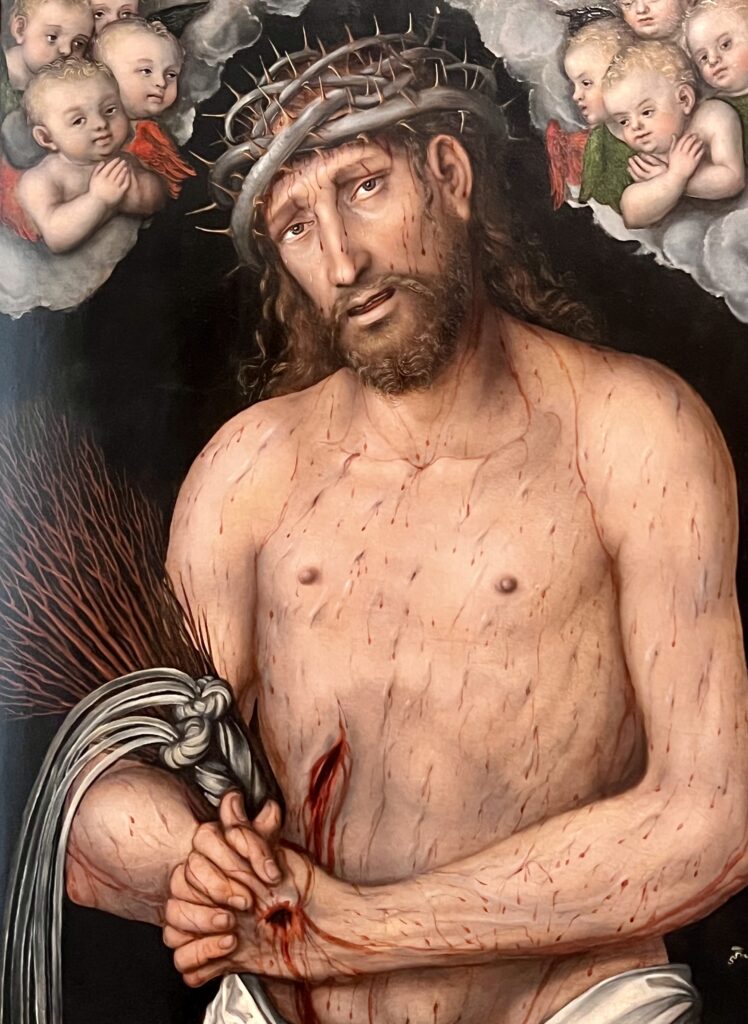
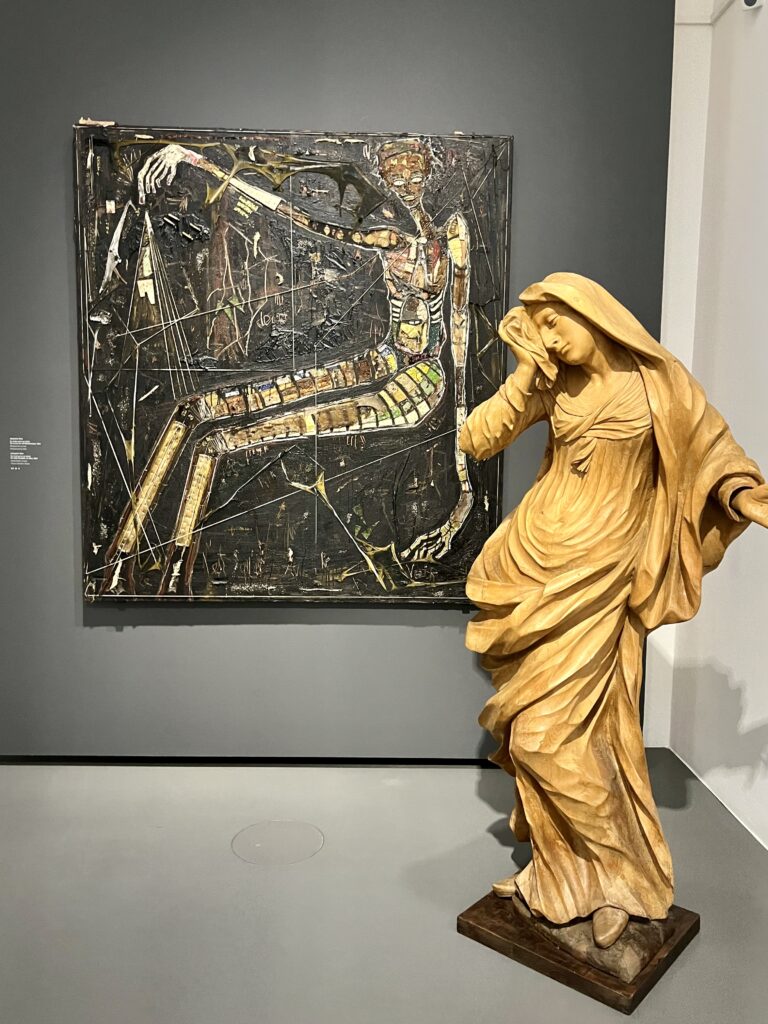
12. Dom Museum
On the northern side of Stephenplatz, you’ll find the Dom Museum. It houses the most valuable items belonging to the Archdiocese of Vienna. There are holy relics, altarpieces, monstrances, reliquaries, and paintings.
Highlights are the only known portrait of Rudolph IV, the sword of St. Ulrich, and 13th century Syrian glass decanters.
I was a bit disappointed that the museum wasn’t part of the all-inclusive ticket. And it was a far cry from other cathedral museums I’ve been to, like the ones in Florence and Siena. On the whole, I don’t really think it was worth 10 euros.
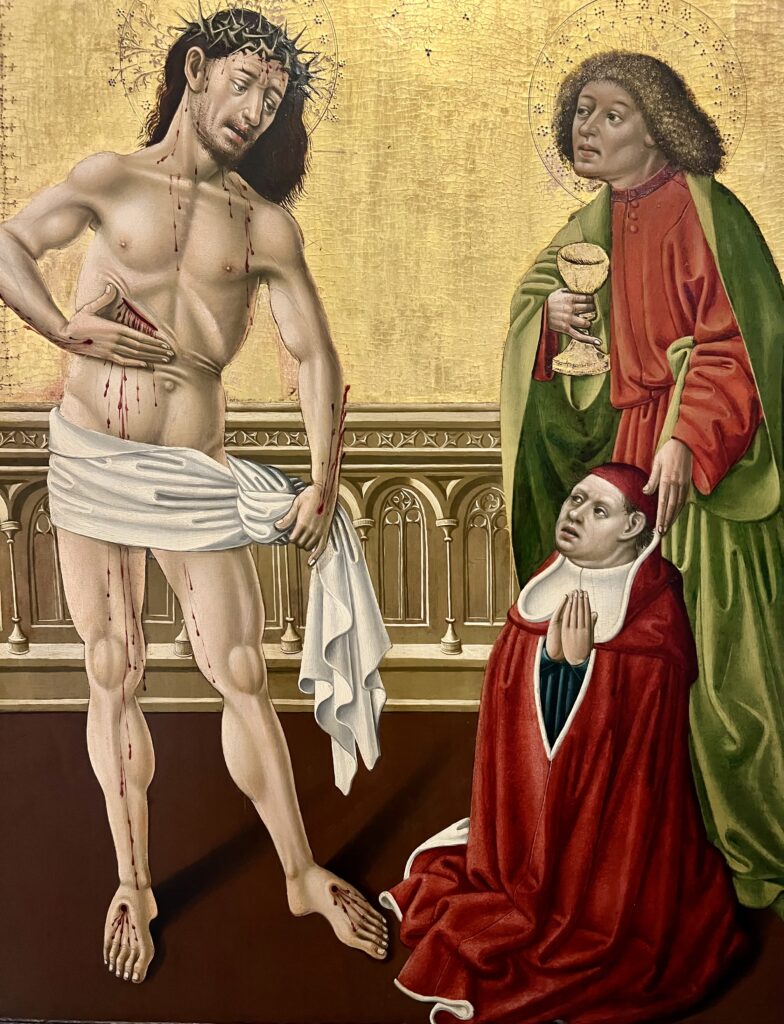
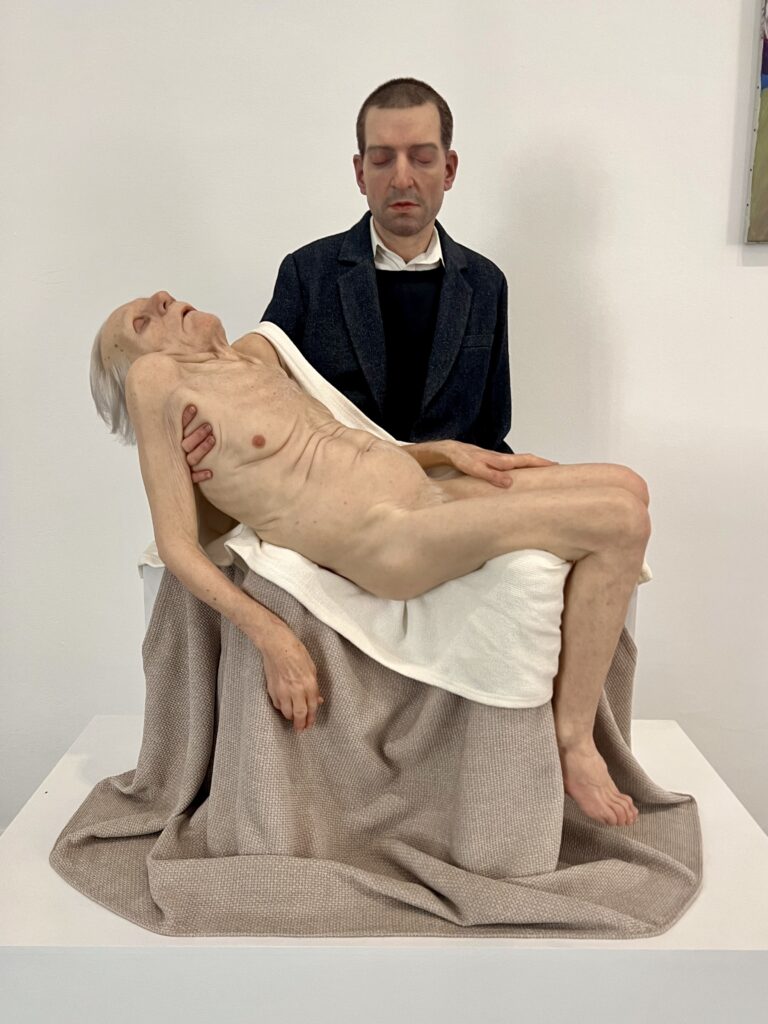
I also wasn’t sure about the pairing of religious artifacts with contemporary art. It didn’t do much for me. If you like contemporary art, head to MUMOK for a better experience.
But the big plus? The Dom Museum is utterly uncrowded and is housed in a modern building with serious air conditioning.
>>> Click here to pre-book a museum ticket
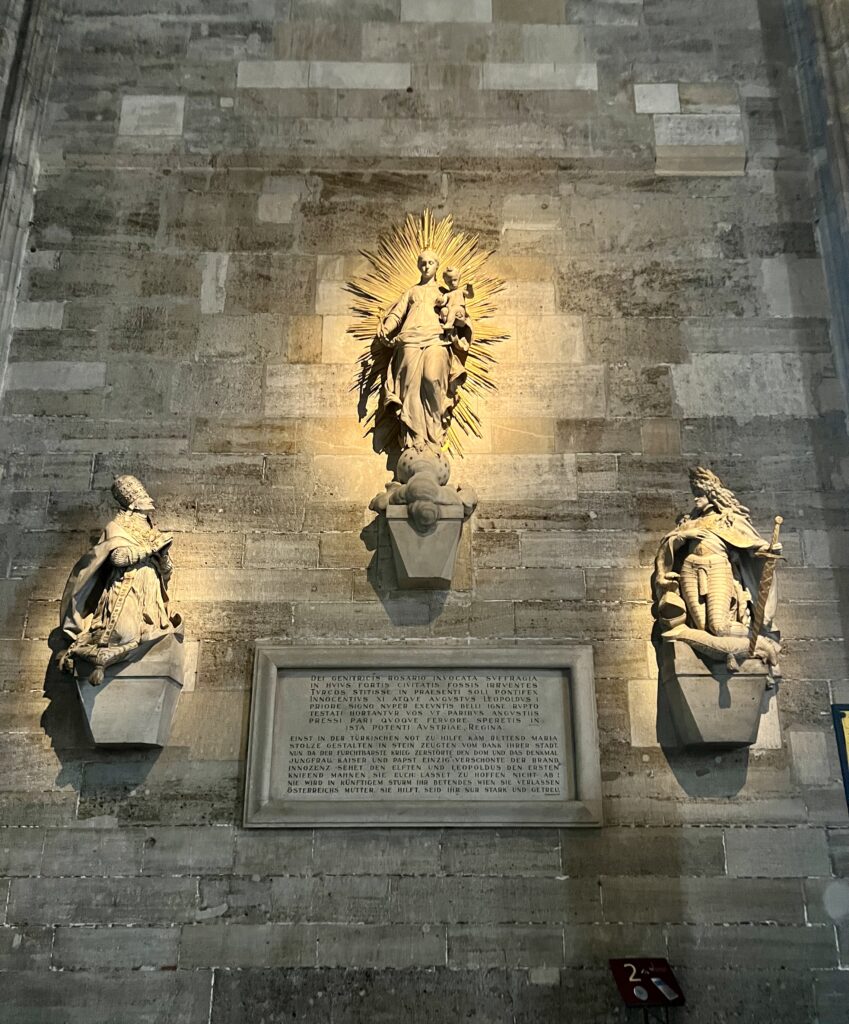
Practical Guide & Tips For Visiting St. Stephen’s Cathedral
Here are some must know tips for your cathedral visit.
Address: Stephansplatz 3. The closest metro station is Stephansplatz (Line U3).
Hours:
The cathedral is open from 6:00 am to 8:00 pm. But visitors are discouraged from entering the cathedral when services are taking place.
That makes the effective visiting hours from 9:00 am to 11:30 am and 1:00 pm to 4.30 pm. (So don’t plan on a lunchtime visit!) On Sundays, the cathedral is only open from 1:00 pm to 4:00 pm.
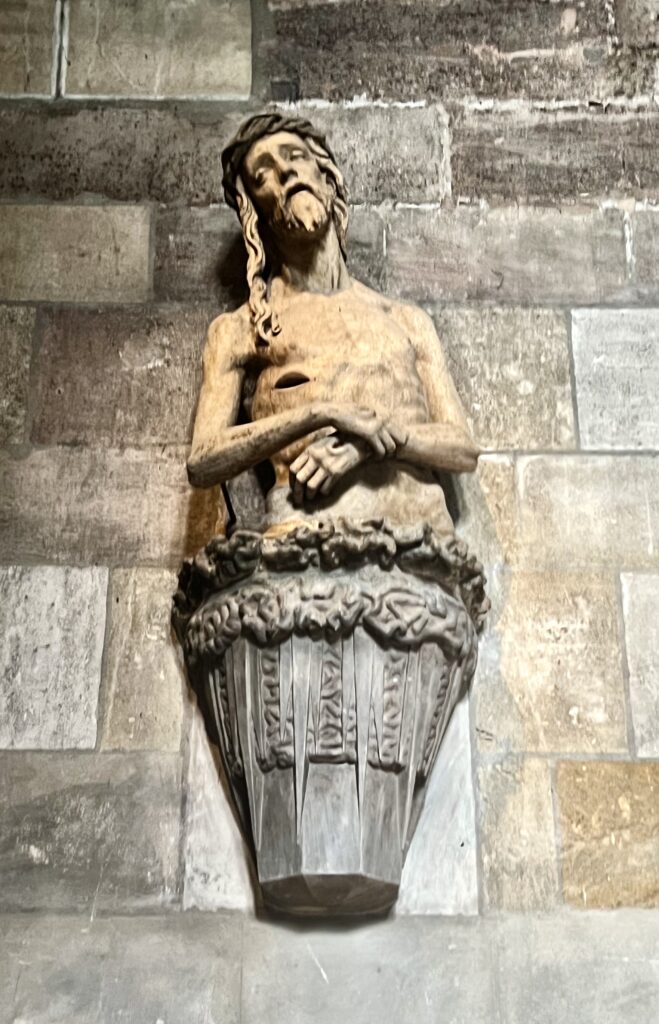
Ticket Prices:
The cathedral itself is free to enter. But, without a ticket, you will only see a small portion of it and won’t be able to walk inside the nave or see the other parts.
Here’s the price breakdown by attraction:
- interior: 6 euros
- south tower: 6 euros
- north tower: 6 euros
- catacombs: 6 euros
- treasury: 5 euros
- Dom Museum: 10 euros
You can pre-book tickets online in advance. Or buy one from the ticket machine onsite.
Since I only saw one machine, I wouldn’t use this option during high season. You’ll just be stuck in a long line. And the shop on the left doesn’t sell tickets either.
You also have free admission with the Vienna Pass, which can be booked for 1, 2, 3, or 6 days of sightseeing. You can also visit the cathedral on a city highlights tour.
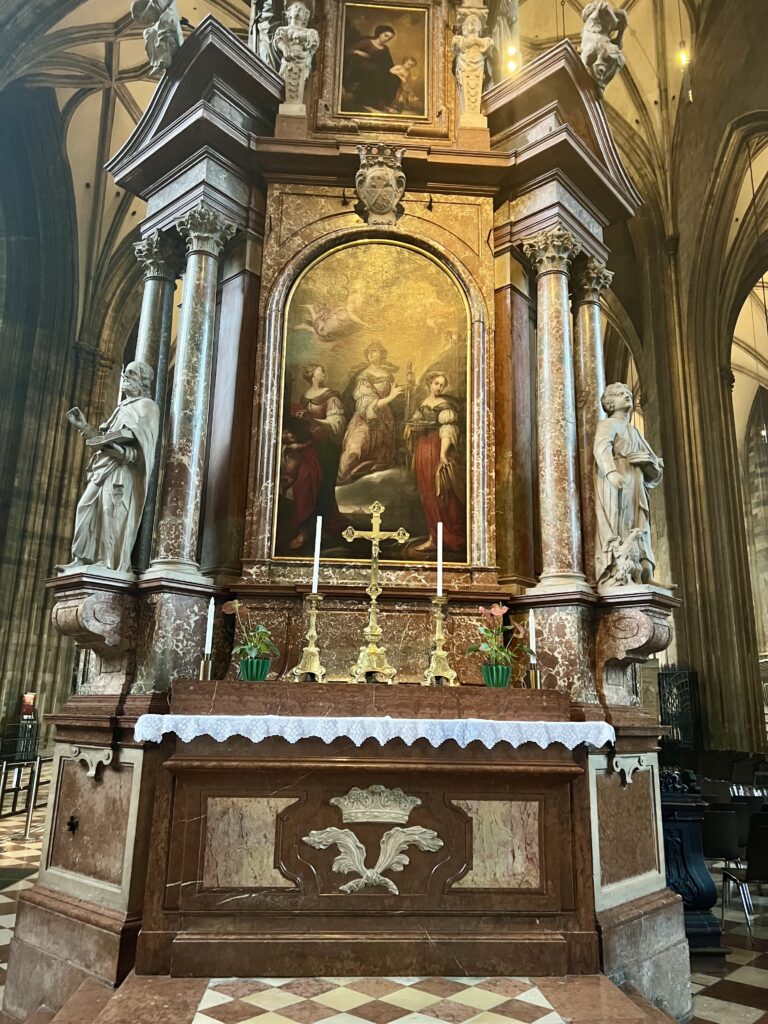
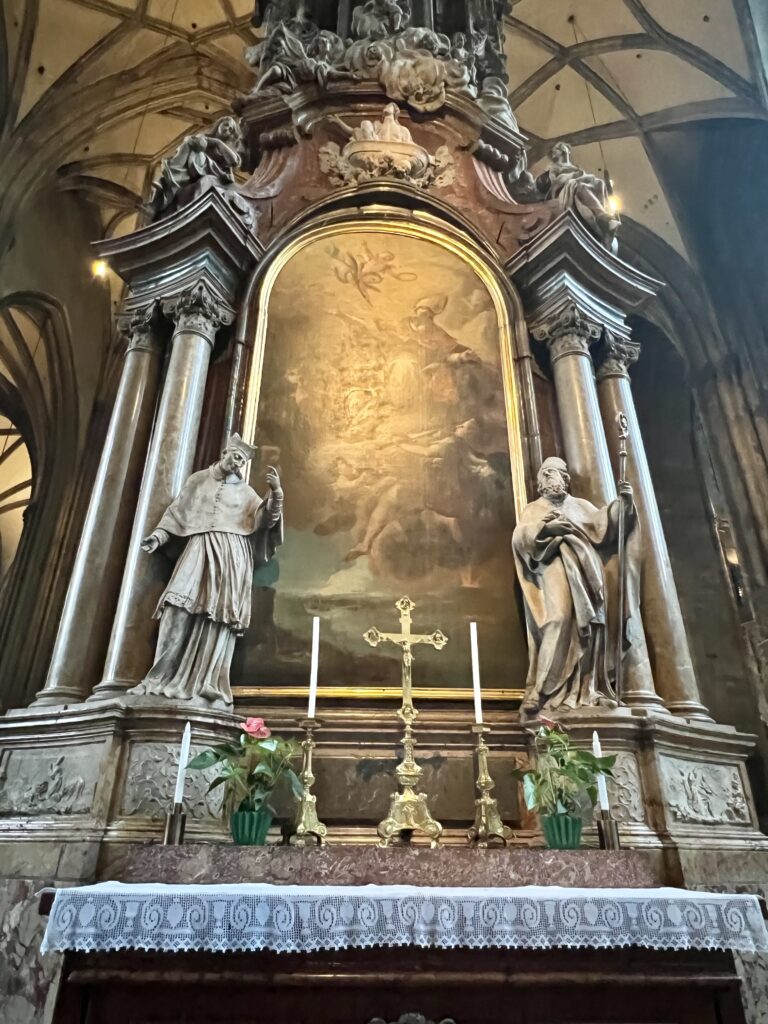
Once inside, you scan a QR code to access the audio guide. Bring earphones or your AirPods. If you press your phone too hard against your ear, it will skip ahead to something different.
Personally, I thought it was much simpler just to purchase the all-inclusive ticket.
The only thing you have to consider is that the treasury doesn’t open until 1:00 pm and you will have to line up at the right time for a catacombs tour.
Since I was visiting in the morning, I missed the treasury in the west gallery. If this is when you plan your visit, you can always keep your ticket and come back later to see it.
As I mentioned, catacombs tours leave every 30 minutes to 2 hours depending on the season. There is usually a sign posted saying when the next tour leaves.
Concerts: St. Stephens holds regular classical music concerts with pieces by Bach, Vivalidi, and Mozart. Click here to pre-book a ticket.
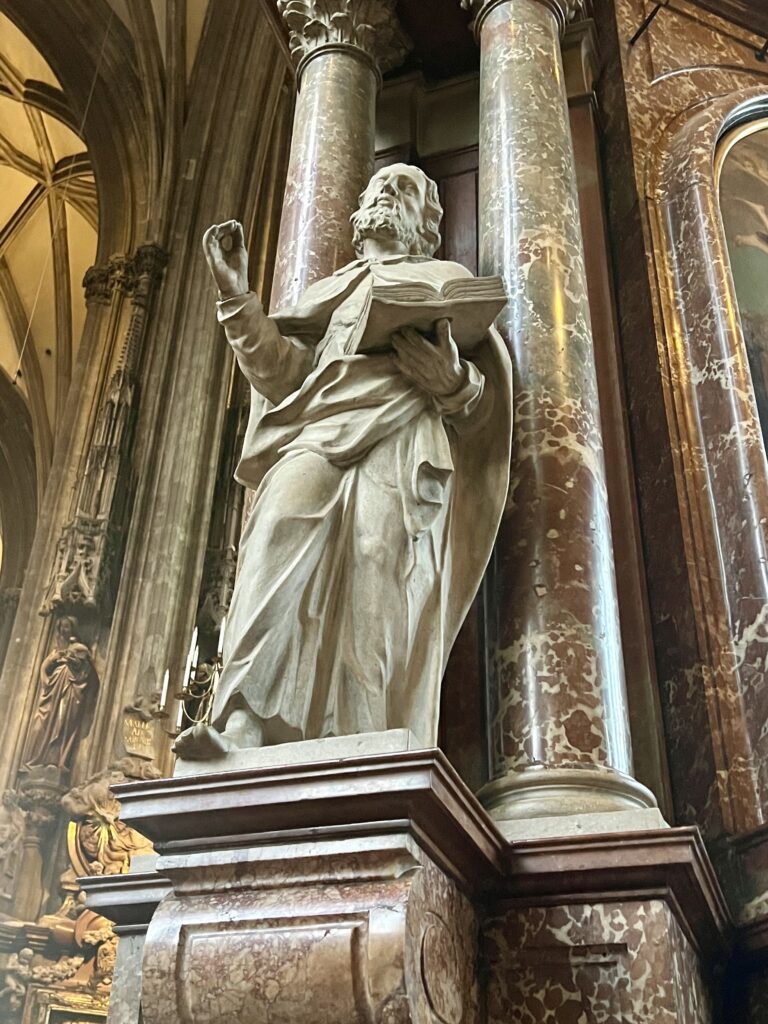
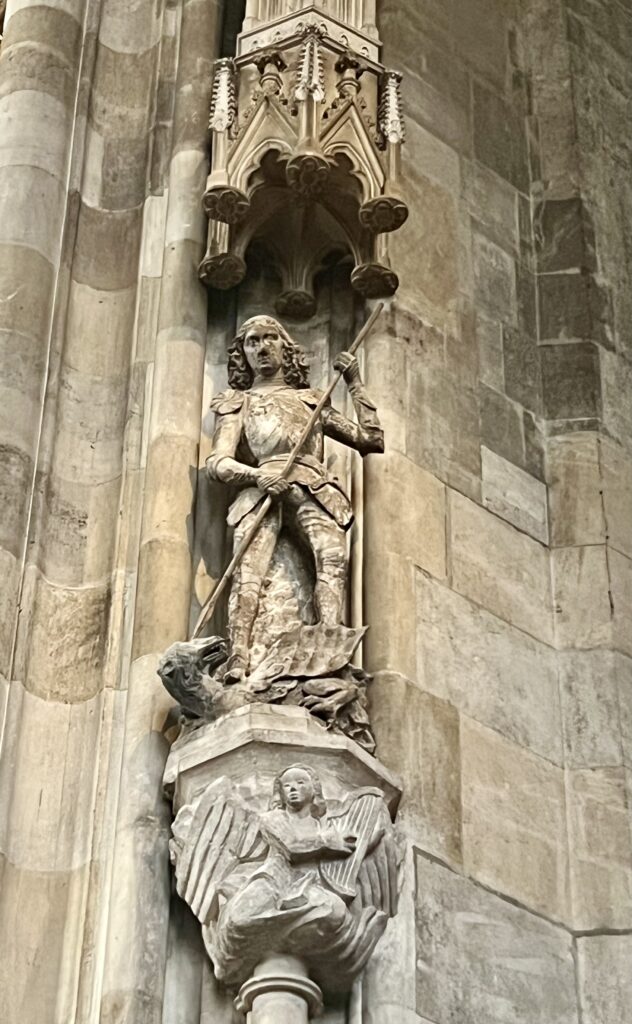
How Long To Spend:
If you just want to visit the free zone, you may only spend 15-20 minutes in the cathedral.
If you want to do everything — explore the interior, tour the catacombs, climb both towers, and go to the Dom Museum — you should budge 2-3 hours. This is especially true if you’re taking time to listen to the audio guide.
Pro Tips:
During high season, you should expect to encounter long lines without a pre-paid ticket. Be forewarned if you embark on a long visit, there are no public rest rooms in the cathedral. But there are in the Dom Museum.
It’s also quite dark in the cathedral and catacombs. This makes it very difficult to get great photos.
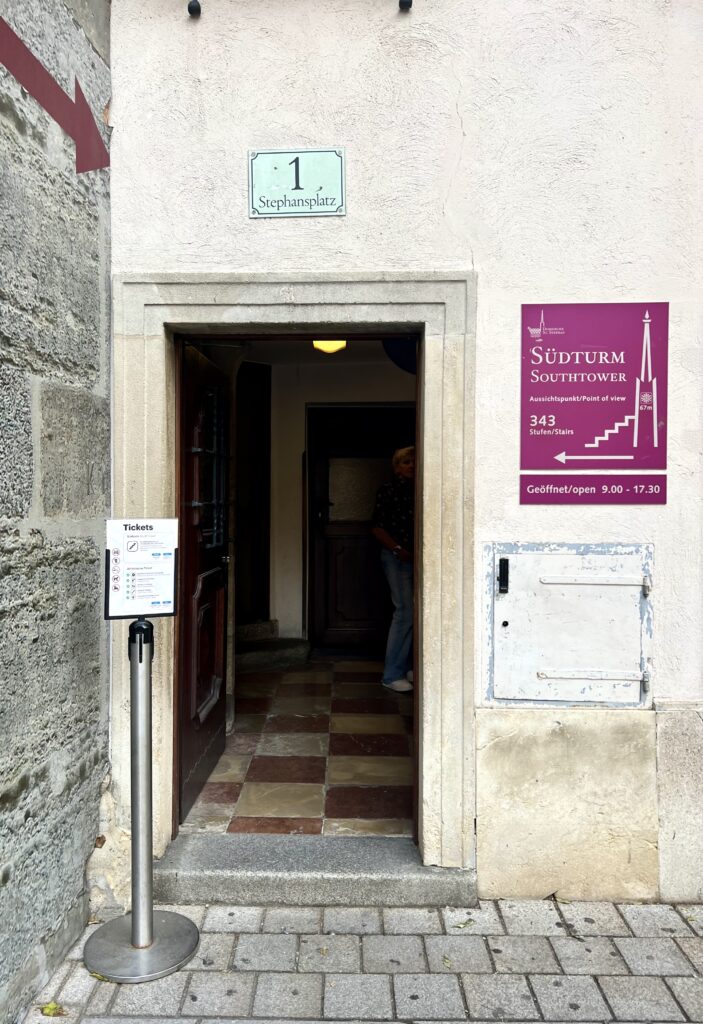
I hope you’ve enjoyed my guide to St. Stephen’s Cathedral. You may find these other Vienna travel guides and resources helpful:
- 3 days in Vienna itinerary
- guide to the Belvedere Palace
- guide to Klimt paintings in Vienna
- guide to the Beethoven trail in Vienna
- what to do in Vienna in winter
- best museums in Vienna
- guide to the Sisi Museum
- guide to the Kunsthistoriches
- guide to the Vienna Secession
- guide to the Albertina Museum
- guide to the Freud Museum
- guide to the Secession Museum
If you need a guide to St. Stephen’s, pin it for later.

